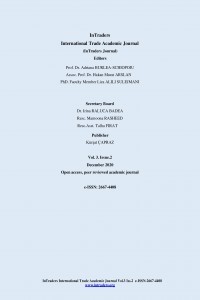Effect of Opening-Up of Indian Economy on Indo-Southern African Trade
Effect of Opening-Up of Indian Economy on Indo-Southern African Trade
Effect of Opening-Up of Indian Economy on Indo-Southern African TradeSHRI PRAKASH1, SONIA ANAND DHIR2 1. Former Professor of Eminence, Birla Institute of Management Technology, Greater Noida. e mail : shri.prakash@bimtech.ac.in2.Assistant Professor, IMS Noida, Sector – 62, Noida. e mail : soniadhir01@gmail.com Abstract Adoption of NEP in 1990-91 was designed primarily to replace slowly growing closed Indian economy by rapidly growing open economy. The study determines the degree of openness of Indian economy and the profile of time path traversed towards this goal under NEP. The opening up of the closed economy is expected to have resulted in changes in magnitude, direction and composition of trade. So, the research question is ‘has the quantum and structure of trade with traditional partners and new partners, if any, changed under NEP? The paper focuses only on Indo-Southern African trade since 1990-91. Rationale of this choice is that both Indian and some Southern African Economies are emerging market economies and these two have close relations for long. Statistical and Econometric models have been used for data analysis to furnish answers to the research question. The major findings of the study indicate that Southern African countries have emerged as new trade partners of India and highlight the need for greater policy focus in case of these new trade partners of India towards enhancing trade by exploring new opportunities.JEL code: F14 Contact info: Dr Shri Prakash : 91- 7840809072, Dr (Prof.) Sonia Anand Dhir : 91-9999693216 Key-Words : Indo African trade, NEP, Emerging Market Economies, Exports
Keywords:
Indo African trade, NEP Emerging Market Economies, Export,
___
- Acharya, S. (2006), Essays on Macroeconomic Policy and Growth in India, OUP,India.
- Adams, R., P. D. J. Gali and G. McGuire. (2003), “The Trade and Investment Effects of Preferential Trading Arrangements: Old and New Evidence”, ProductivityCommission Staff Working Paper, Canberra.
- Beri, R. (2003). India’s Africa Policy in the Post-Cold War Era: An Assessment. Strategic Analysis, Vol. 27, No. 2, Apr-Jun 2003
- Bharadwaj, R. and Bhagwati, J, (1969).Human Capital and Pattern of Foreign Trade- The Indian Case. In Mathur P. N. and Venkatramaiha, P. (Editors). Economic Analysis in Input Output Framework. Vol.II, GIPE, Pune.
- Cheru, F., Obi ,C. (Editor.) The rise of China and India in Africa Challenges, opportunities and critical interventions, Zed Books, London
- Dutta, D. (Editor, 2000), Economic Liberalisation and Institutional Reforms in South Asia:Recent Experiences and Future Prospects, Delhi, Atlantic, 2000,
- Heckscher, E. (1919). The Effect of Foreign Trade on The Distribution of Economy. Economisk Tidskriff. American Economic Association. 497-512.
- Jain, Rajesh (2008), Determinants of Success or Failure of Family Business in Pharmaceutical Industry of India since 11980, Ph.D. Thesis, Center of Research Studies, BIMTECH, Greater Noida and B.R. Ambedkar University, Agra.
- Leontief, W.W.(1953). Domestic Production and Foreign Trade- The American Capital Position Re-examined. Proceedings of the American Philosophical Society, Vol. No. 97.
- Longo, R. (2004). Economic Obstacles to Expanding Intra-African Trade. World Development, Elsivier Volume 32, Issue 8, Pages 1309–1321
- Mathur, P.N. (1963). Gains in Economic Growth From International Trade. Kyklos,Vol. No. 16.
- Mathur, P.N, K.R. and Skolka (Eds).(1988). South-South Cooperation and Development Polenske, Applications of Input Output Analysis, Macmillan. Ministry of Finance, Government of India, Economic Survey, 2013-14
- Ohlin, B.(1967). Interregional and International Trade. Harvard Economic Studies. Cambridge, Harward University Press.
- Prakash , S, Dhir A.S., Growth, Factor Endowment and Trade of India – A Review of Literatures, Manathan, Volume IX, Issue 4-5, December 2014
- Prakash, S, and Dhir Anand Sonia (2014), Impact of Growth on Factor Endowment and Structure of India’s Trade, IOSR Journal of Economics and Finance, Voume 5, Issue 5,
- Prakash, Shri, (1996), New Economic Policy and Relevance of Nehru-Mahalanobis Strategy of Growth. In Sinha, Ajit Kumar (Editor), New Economic Policy of India. Deep & Deep Publication.New Delhi.
- Rajen H. (2002). Recasting Indo-African Development Cooperation. Economic and Political Weekly. Vol. 37, No. 40, pp. 4116-4120
- Rosander, A.C.,Elementary Principles of Statistics, Vol. No.3
- Y A Yule, Y. A. (1927),Time Series Modeling and Likelihood of Spurious Results, Journal of Royal Statistical Society of, London)
- Yayın Aralığı: Yılda 2 Sayı
- Başlangıç: 2018
- Yayıncı: Kürşat ÇAPRAZ
Sayıdaki Diğer Makaleler
Effect of Opening-Up of Indian Economy on Indo-Southern African Trade
Sonia Anand Dhir, Shri Prakash
Avrupa Birliği’nde Ülkeler Arası Emeklilik İhracatı (Transferi)
SÜRDÜRÜLEBİLİRLİK, İŞVEREN MARKASI OLUŞTURMA VE YETENEK YÖNETİMİ UYGULAMALARI ARASINDAKİ İLİŞKİLER
IMPACT ON MARKETING DUE TO POLITICAL INSTABILTY ON PEOPLES FOOTFALL VIA TOURISM ON J&k INDIA
Umer Qadir SOFİ, Umer Qadir SOFİ
